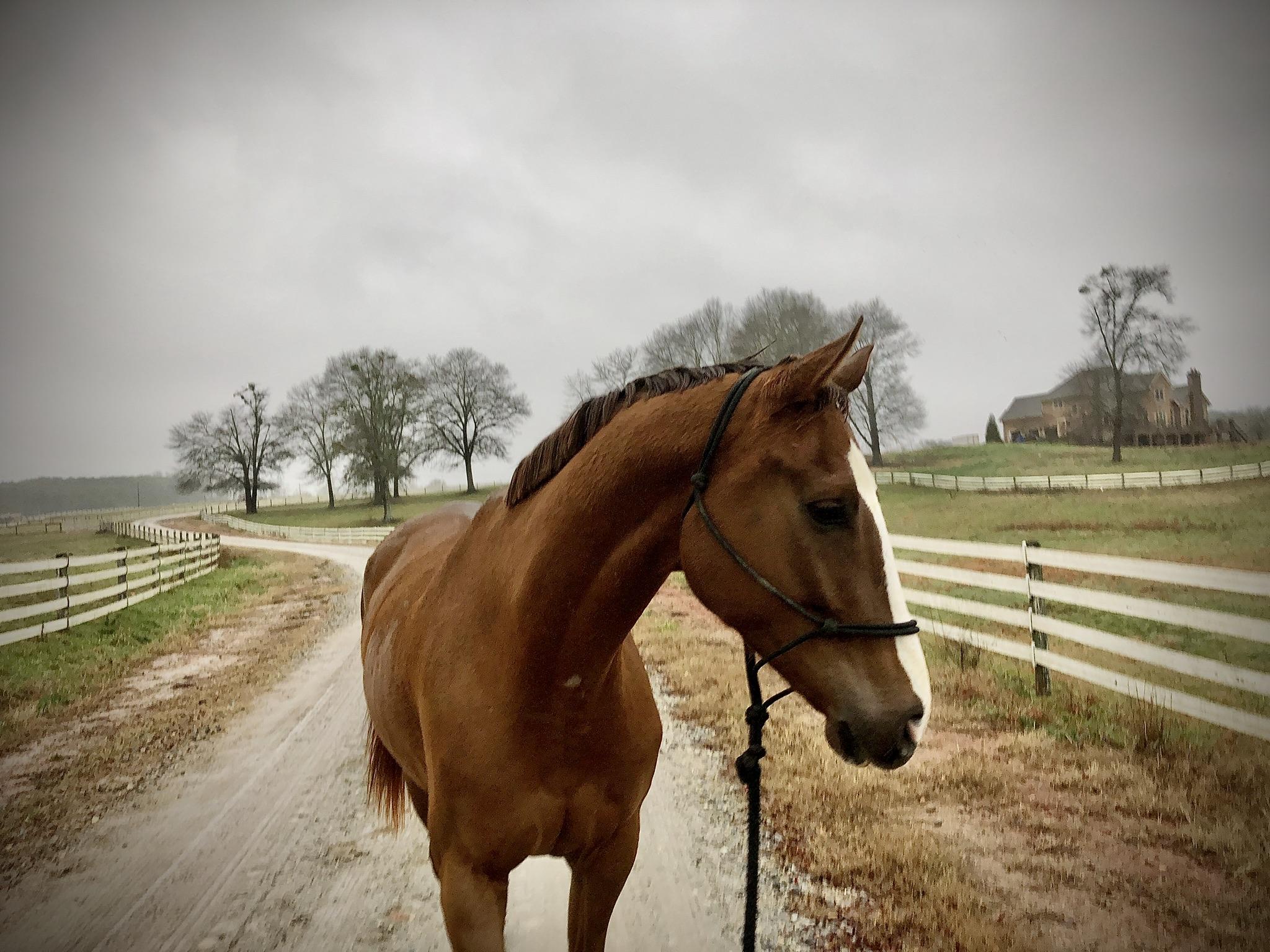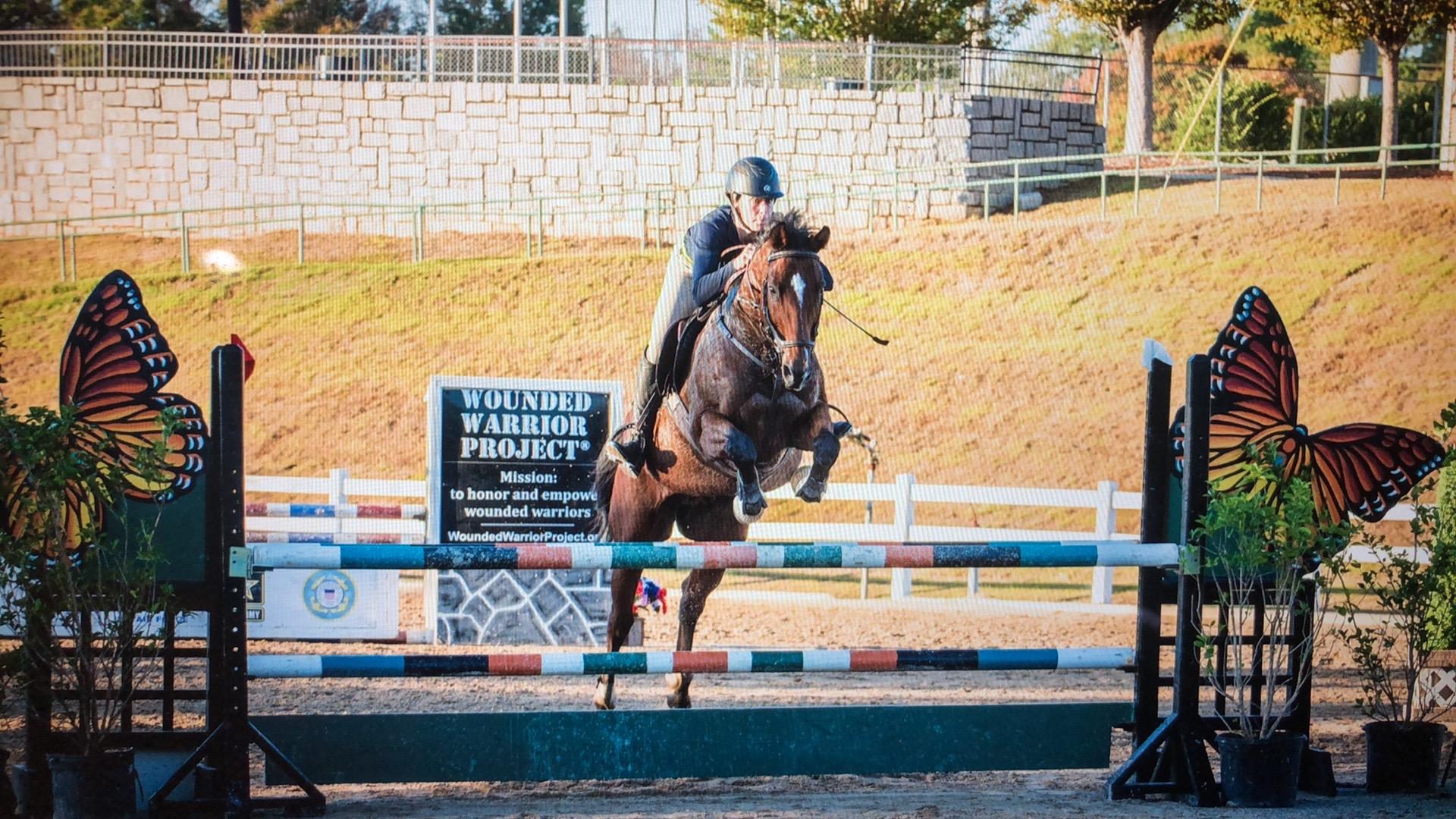
Thoroughbred Logic, Presented by Kentucky Performance Products: “Enough Rope”
“I have rarely seen a micro-managed horse get quieter when when a hand holds with down pressure near the lead rope snap.”
Welcome to the next installment of Thoroughbred Logic. In this weekly series,Anthropologist and trainer Aubrey Graham, of Kivu Sport Horses, will offer insight and training experience when it comes to working with Thoroughbreds (although much will apply to all breeds). Come along for the ride as she discusses her logic on allowing her horses “enough rope to hang themselves.”
At some point last year, a young woman came to see if my place was going to be a good spot to consign her Thoroughbred. We walked around and I introduced her to the horses and let her watch me ride. During that ride, I removed my vest and tossed it on a standard while Luc (JC: Calpullec) stood quietly. At end of the hack, I grabbed it from the jump and rode up into the barn past the pig. Like a good kid, he didn’t flinch. I saw her stare.
Before leaving, she assessed the situation: “I don’t know if my guy will be a good fit.” She paused. “He’s just not as quiet as all the other Thoroughbreds here.”
“Oh, they didn’t all start like this,” I laughed, and proceeded to pull up images of a few of them from when they had just arrived. Ahem, Juice (JC Pulpituity), Forrest (JC Don’t Noc It), Crafty (JC Crafty Charger), I see you.

Still one of my favorite, terrifying “before” pictures of Juice (JC Pulpituity). Photo by Nikki Sherman.
There are a lot of reasons why former racehorses quiet down and adjust to the post-track life in second-career farms across the country. Quality turnout, nutrition, and training certainly contribute significantly. In addition, my favorite (on the ground) “hot-be-gone” tool is an idiom: “give them enough rope to hang themselves.”
While holding a lead rope attached to a 1200-pound animal, this idiom becomes a literal thing. It’s also one of the few actions that I insist that everyone who handles horses here also does: walk the horse holding enough rope for you to move comfortably with your hand low, your arm relaxed. Be alert and prepared, but still give them “enough rope,” even if they are snorting and prancing, even if the other horses are running, even if you’re pretty sure all hell might break loose at any given moment.

Ranger (JC Cowboy Night), Chille (JC Schiller Sound), Fletcher (JC Reflection), and Birdie (JC Birdie Bob) coming in from the field. Photo by Greg Lyon.
If they push into your space, if they don’t stop when you stop, or if they simply try to drag off in other directions, correct them once and then go right back to doing what you were doing. The “enough rope” concept allows horses to screw up, make the wrong decision and then, with consistency and boundaries, to learn the right one. It sounds idealistic when written down, but in a way, it permits freedom, choice and an almost equine form of critical thinking. In the process, it takes the anxiety that seems to come with micromanagement out of the game for both horse and handler.
On that note, I have found that the “hold tight” version of walking Thoroughbreds seems to be reasonably common. Maybe it is conditioned, maybe it is anxiety, maybe it is just a desire for the horse to always get the right answer… Regardless of why this happens, I have rarely seen a micro-managed horse get quieter when when a hand holds with down pressure near the lead rope snap.
Conversely, with “enough rope” they usually chill out and are able to be lead in and out with multiple other horses at a time, stop when you stop, and stand quietly when getting un-haltered for turnout. This same tactic makes it possible to take blankets on and off in stalls while stall doors remain open. Nope, they don’t make a run for it.

Boomer, Rhodie, and Ranger grazing quietly at the Retired Racehorse Project’s 2021 MegaMakeover at the KY Horse Park. Photo by Aubrey Graham.
To that point, no, Luc was not good with mounted-vest-removal or anything to do with the pig when he first arrived. With time and relaxed consistency though, he figured it out.

Luc adjusted to the pig after a little while. And good grief, Pig was tiny then. Pic from 2019. Photo by author.
Like most things I’ll write in this series, this concept is far from new or revolutionary. Folks engage versions of similar training tactics with all breeds from the time they are getting halter broke. Moreover, most racehorses are trained in proper manners from when they are foals, especially in advance of any sales or auctions. Expectations, class, equipment, and handling may differ from groom to groom, track to track, but most Thoroughbreds are quick to understand expectations and boundaries and (re)gain their manners as they start second careers.
Just as this idea is not specific to breed, it is equally not specific to species. Hell, I learned this process from how my father trains dogs. Walk with a loose leash, don’t let them pull, correct behavior once and praise the right response. When you stop, the dog should be paying enough attention that they too stop and sit at your left heel. Horses might be on the right-hand side, but they all get the same training.

Rhodie (JC Western Ridge) taking the “enough rope” thing to a whole new level. Photo courtesy of author.
And sure, this is easy to apply when horses are generally well-behaved. It is more difficult with situations like stall-rest-hand-walking, off-property explorations, and other adventures in equine-kite-flying. Keeping a loose line and confident set of corrections and praise is challenging when your horse spends more time on two legs than on four. My unsolicited advice: safety first, laugh at them second, and then (on as relaxed a line as possible) keep doing what you were doing.

Forrest (JC Don’t Noc It, shown here at his first show in 2018) was infamous for bad behavior off property. Managing him on a loose line (rein) helped him learn to make better decisions and keep his feet closer to the ground (even if he still tests the boundaries Every. Single. Time). Photo by Christina Farrell.
When Juice was on stall rest for his chronic suspensory injury, hand walks were extremely “interesting.” One morning in January, while my dad was visiting, I walked Juice up the driveway, coffee in my left hand, rope halter lead-line in my right. He reared and kicked (not in my general direction) and pranced next to me. My non-horsey dad, shouted from the door, “That horse is going to get you killed! Who does he belong to anyway?!”

Juice (JC Pulpituity) doing pretty good job keeping all four feet near the ground for a hand walk during stall rest back in early 2020. Photo by author.
I laughed, because what else can you do? “He’s mine. And no, he’s not going to hurt me. But I’ll be pissed if he spills my coffee.” Once all four hooves were back close to the ground, I walked on and Juice passaged his way up the road. The line remained loose and the coffee stayed (mostly) in the mug.
About Kentucky Performance Products, LLC:
Omega-3 fatty acids have been proven to reduce skin inflammation and mitigate allergic response. Contribute delivers both plant and marine sources of beneficial omega-3 fatty acids. Feed one to two ounces per day, depending on severity of the allergy.
Need tips on how to manage allergies? Check out this KPP infographic: Got Allergies?
The horse that matters to you matters to us®. KPPusa.com







